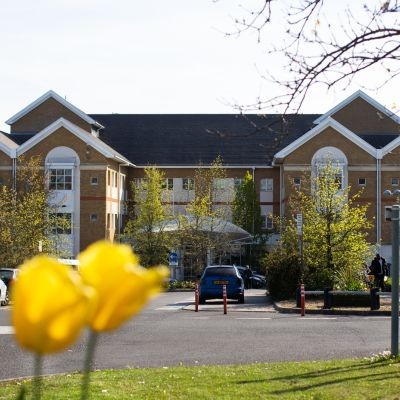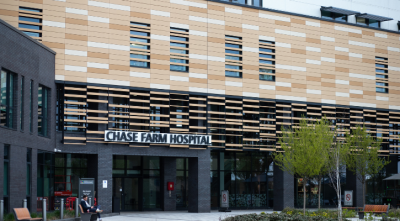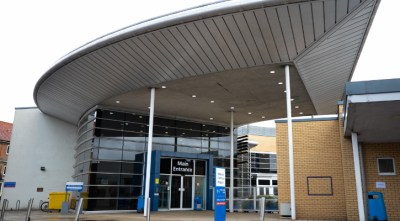The Royal Free London is a national provider of scleroderma care.
Our scleroderma team is linked with University College London, offering ongoing clinical care (sometimes in partnership with your local rheumatologist), a range of clinical trials, and undertaking extensive research into the disease.
Email: rf.
Scleroderma pathway manager
Tel: 020 3758 2042 and select option 2, then option 3
PITU intravenous infusions
Tel: 020 3758 2042 and select option 3
Scleroderma patient navigator
Tel: 020 3758 2042 and select option 4
Clinical advice line
Tel: 020 3758 2042 and select option 6, then option 1
Repeat prescriptions and blood monitoring
Tel: 020 3758 2042 and select option 6, then option 2
Biologics, homecare prescriptions and blood monitoring <H3>
Tel: 020 3758 2042 and select option 6, then option 3
Scleroderma patient expert
Tel: 020 7794 0500 ext 35131
Scleroderma is an autoimmune condition that affects the skin and connective tissue.
A person living with scleroderma will have an overactive immune system, meaning the body attacks its own healthy tissues, causing hardening and scarring.
Scleroderma is an umbrella term that refers to the various types of this rare and complex condition. It comes from two Greek words: 'sclero' meaning 'hard' and 'derma,' which means 'skin'. Hardening of the skin is often the first sign that people notice, which occurs because the body is producing too much collagen.
It is thought around 2.5 million people worldwide are affected by scleroderma, which can range from mild to severe and in some cases may even become life-threatening.
Every person’s story is unique and no two cases are ever identical.
Types of scleroderma
How an individual will be affected by their condition will depend on the type of scleroderma they have.
There are two main types of scleroderma: localised scleroderma and systemic sclerosis.
Localised scleroderma will mainly affect the skin, and for many people this is a milder form of the disease.
In systemic scleroderma (systemic sclerosis), some of the internal organs are involved as well, such as the heart, lungs, or kidneys.
Raynaud's phenomenon is often a common symptom of both types of scleroderma
As part of our scleroderma service, we facilitate a nurse-led primary Raynaud’s service that accepts referrals from GPs, consultants and trainees from across the UK.
The clinic provides patients with a service dedicated to the assessment of new onset or long-standing Raynaud’s phenomenon.
It comprises of a clinical consultation and has direct access to the designated phlebotomy service.
Patients will also see the departmental clinical scientist for capillaroscopy and thermography to determine clinical significance. The coordination of these tests within the same clinic appointment offers a seamless service to provide a quick diagnosis.
The close link with the scleroderma clinic will ensure a prompt referral of cases that progress to a connective tissue disease.
Patients will receive verbal and written information on their condition, including risk factor advice, lifestyle modification and medication. All patients will be provided with a contact telephone number for the nurse-led advice line, which provides ongoing support and information.
The UK scleroderma study group (UKSSG) is a working group comprising of key centres with a clinical and research interest in scleroderma.
The group was established by Professor Dame Carol Black on the principle of inclusive participation.
Any clinician with an interest in scleroderma and a wish to be involved in the research activities of the group is invited to join.
It meets formally twice each year. A key role for the group is to foster collaborative research, and a series of recent studies in the UK have used the UKSSG infrastructure to facilitate collaboration.
Athena
This study is testing a drug called PRA023. PRA023 is a humanised immunoglobulin G monoclonal antibody (man-made antibodies that act like human antibodies) in those with diffuse scleroderma. PRA023 can potentially improve the symptoms of scleroderma interstitial lung disease and prolong survival.
Horizon
This study is testing a drug called HZN-825, to treat diffuse scleroderma. The study is to evaluate the effectiveness (how well this study drug works) and the safety and tolerability of this study drug.
Mitsubishi
The study involves a drug named MT-7117 (dersimelagon) for the treatment of diffuse scleroderma. The study is to evaluate the effectiveness and the safety and tolerability of this study drug, MT-7117, over 60 weeks.
CoDUo
This is a study aiming to co-design scleroderma digital ulcer selfcare interventions and improvement opportunities with patients and healthcare professionals.
Minimise
The study is testing a drug called Mycophenolate Mofetil (MMF) in participants with limited scleroderma. Mycophenolate Mofetil is usually prescribed for patients with diffuse scleroderma as the standard treatment. The study is trying to find out if MMF can slow down disease progression in patients with limited scleroderma.
SHED
This study is looking at sharp-debridement of digital ulcers in patients with scleroderma. The study is aiming to see if removing the dead skin from an ulcer has the potential to help healing.
Acceleron
The study is to evaluate the effectiveness and the safety and tolerability of ACE-1334 and standard of care in patients with scleroderma.
Bioresource RDC – SSc
This is a genetics study aimed at people with rare diseases such as scleroderma. The National Institute for Health and Care Research (NIHR) BioResource - Rare Diseases (NIHRBR-RD) aims to help with the development of more affordable DNA-based tests for the diagnosis of rare diseases where the gene is known and the discovery of genes causing rare diseases. Currently only half of the genes for rare diseases are known.
SATISS
This study is looking to validate thermography (which measures skin temperature) as an outcome measure for Raynaud’s phenomenon.
SPIN
This is an observational study to learn more about important problems faced by people living with scleroderma, such as fatigue, emotional distress and physical limitations. The study also aims to develop and test internet-based interventions to support people in their efforts to cope with living with scleroderma.
STRIKE
this is a scleroderma observational study aiming to predict who will likely undergo disease progression in the future. It involves collecting sequential blood samples and imaging data over a seven year period.
SMART
The study aims to establish a formalised process for data and sample collection for all systemic sclerosis patients in the UK, as well as from people with other scleroderma spectrum conditions, including morphoea, Raynaud’s phenomenon and from control subjects without those conditions.
Dessipher
This study is part of the SMART study.
Pastul
This is patient self-assessment of skin thickness in upper limb observational study in scleroderma.
IMID
This is part of the National Institute for Health and Care Research BioResource genetics study. It aims to help research into the causes of Immune-Mediated Inflammatory Diseases (IMID) and understand determinants of IMID severity and treatment response.
Elucidating the pathogenesis of systemic sclerosis
This is a study to understand the cause of scleroderma. The study is studying skin, tissue and blood samples from scleroderma patients and healthy volunteers.
Scleroderma studies which will start soon
BI 685509
This is a study in people with diffuse scleroderma to test whether BI 685509 drug influences lung function and other scleroderma symptoms.
Handsome
This study aims to explore hand function impairments in scleroderma.
Belimumab
This study seeks to evaluate the efficacy and safety of belimumab administered subcutaneously in adults with scleroderma associated interstitial lung disease (SSc-ILD).
Daisy
This is a randomised study to evaluate the effectiveness of a drug called Anifrolumab compared to placebo in patients with scleroderma aged 18 to 70 years of age. This drug will be administered via subcutaneous insertion.
RO7303509_Genetech
The study is to evaluate the effectiveness and the safety and tolerability of multiple doses of RO7303509 in scleroderma patients.
Inflammation, tissue repair, scarring and fibrosis have an essential and important role in the normal biological processes of cells, tissues and organs. They are also involved in some of the most common and severe diseases.
The FLARRE consortium seeks to better understand the processes involved in these disorders and support the management and treatment of such conditions.
It unites basic, biomedical and clinical scientists at all levels from across University College London (UCL) with industrial and international collaborators.
FLARRE aims to highlight research in inflammation, tissue remodelling, scarring and fibrosis, to develop a UCL cluster of expertise and research excellence.
This is translated into commercial enterprise, leading to improved patient care.
Our patients and their families are invited to the annual Scleroderma Family Day.
The next one is on Saturday 18 May 2024 in the William Wells Atrium at the Royal Free Hospital.
Previous family day talks
We try and stay in touch with our patients as much as possible, and one way of doing this is via our annual Christmas newsletter.
Every patient who attends the scleroderma and Raynaud's clinics is added to our newsletter mailing list, which is used solely for mailing the Christmas newsletter.
If you do not wish to receive the newsletter and would like your name removed from the mailing list, please email kim.
Previous newsletters
| Thumbnail | Title | Size |
|---|---|---|
| Scleroderma 2022 Christmas newsletter | 0.34 MB |
GPs can receive prompt advice and guidance for any rheumatology query from a rheumatology consultant, from Monday to Friday, via the NHS e-Referral Service — please include any relevant documents, such as letters or photographs, in messages. Tertiary referrals from other hospitals are also accepted.
A reply is guaranteed within three working days.
Scleroderma and Raynaud’s service referral information
Referrals should be made by UK rheumatology services in writing and sent to rf.
Scleroderma and Raynaud’s patient information and education
The scleroderma service has received funding from the Royal Free Charity, including towards an ulcer project, which you can read more about on the charity's website.
 Translate
Translate








